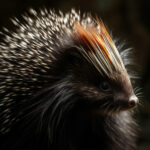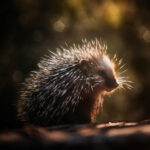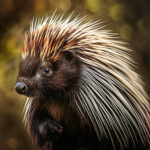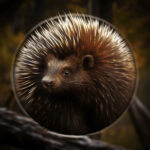Porcupines are fascinating creatures that are known for their unique quills and defensive behavior. One question that often arises when discussing porcupines is whether they are nocturnal animals. In this article, we will explore the behavior and habits of porcupines to determine if they are indeed nocturnal. We will delve into their activity patterns, feeding habits, and habitat preferences to shed light on this intriguing aspect of their lives. So, let’s dive in and uncover the truth about porcupines and their nocturnal tendencies.
Key Takeaways
- Porcupines are primarily nocturnal animals.
- They are most active during the night and rest during the day.
- Their nocturnal behavior helps them avoid predators and find food more easily.
- Porcupines have adapted to a nocturnal lifestyle through their specialized senses and behaviors.
Understanding Porcupines: An Overview

A. What are Porcupines?
Porcupines are fascinating creatures that belong to the rodent family. They are known for their unique defense mechanism – a coat of sharp quills or spines that cover their bodies. These spines are actually modified hairs that are designed to protect the porcupine from predators. When threatened, a porcupine will raise its quills, making itself appear larger and more intimidating.
There are several species of porcupines found around the world, each with its own distinct characteristics. The most well-known species is the North American porcupine, which is native to the United States and Canada. Other species can be found in various parts of Africa, Europe, and Asia.
B. Where are Porcupines Native?
Porcupines have a wide distribution and can be found in many different habitats across the globe. They are native to various regions, including North and South America, Europe, Africa, and Asia. In North America, the North American porcupine is commonly found in forests, grasslands, and deserts. In Africa, the crested porcupine is prevalent in rocky areas and savannas.
These adaptable creatures have managed to thrive in a range of environments, from dense forests to arid deserts. They have even been spotted at high altitudes in the Himalayas. Porcupines are highly adaptable and can survive in diverse climates and terrains.
C. The Unique Anatomy: Why do Porcupines have Spines?
One of the most distinctive features of porcupines is their spines. These spines serve as a form of protection against predators. When threatened, a porcupine will raise its quills, making it difficult for predators to attack. The quills are sharp and barbed, making them painful to remove once embedded in an attacker’s skin.
Contrary to popular belief, porcupines cannot shoot their quills. Instead, the quills detach easily upon contact, allowing them to stick into the predator’s skin. This defense mechanism is highly effective in deterring potential threats.
Porcupines also have other unique adaptations that aid in their survival. They have strong claws for climbing trees and are excellent swimmers. Additionally, their teeth are specially adapted for gnawing on bark, twigs, and other vegetation that makes up their diet.
In conclusion, porcupines are fascinating creatures with a range of interesting adaptations. Their nocturnal habits, unique anatomy, and ability to thrive in various habitats make them a captivating species to study. Whether you encounter a porcupine in the wild or learn about them from afar, these remarkable creatures are sure to leave a lasting impression.
Unraveling the Nocturnal Nature of Porcupines
A. Are Porcupines Nocturnal or Diurnal?
Porcupines are fascinating creatures known for their unique appearance and defensive quills. One common question that arises when discussing porcupines is whether they are nocturnal or diurnal. To shed light on this matter, let’s explore the behavior and habits of these intriguing animals.
Porcupines are primarily nocturnal, which means they are most active during the night. This nocturnal behavior is observed in many wildlife species, including various rodents. Nocturnal animals have adapted to thrive in low-light conditions, utilizing their enhanced senses to navigate and hunt for food during the darkness.
B. When are Porcupines Most Active?
Porcupines are most active during the nighttime hours. As the sun sets and darkness envelops their habitat, these creatures emerge from their dens or nests to begin their nightly activities. This behavior allows them to avoid potential predators and take advantage of the cover of darkness.
C. What Time of Day are Porcupines Active?
Porcupines typically become active shortly after dusk and remain active throughout the night. While their exact activity patterns may vary depending on factors such as season and habitat, it is generally safe to say that porcupines are predominantly active during the late evening and early morning hours.
D. Why are Porcupines Nocturnal?
The nocturnal nature of porcupines can be attributed to several factors. One reason is their diet. Porcupines are herbivores, feeding primarily on leaves, bark, and other plant materials. Many of the plants they consume are more easily accessible and abundant during the night, when the temperature is cooler and the moisture content is higher. By being nocturnal, porcupines can take advantage of these favorable conditions to find their preferred food sources.
Another reason for their nocturnal behavior is the need to avoid predators. Porcupines have a formidable defense mechanism – their sharp quills. However, they are not particularly fast or agile, making them vulnerable to predators such as coyotes, bobcats, and mountain lions. By being active at night, when many of their predators are less active, porcupines increase their chances of survival.
In addition, the darkness provides porcupines with a level of camouflage, making it easier for them to blend into their surroundings. This helps them avoid detection by both predators and potential threats from other animals.
In conclusion, porcupines are primarily nocturnal animals. Their nighttime activity allows them to find food more easily, avoid predators, and take advantage of the cover of darkness. Understanding the behavior and habits of these fascinating creatures adds to our appreciation of the natural world and the diverse strategies animals employ for survival.
The Nightly Adventures: Porcupines After Dark
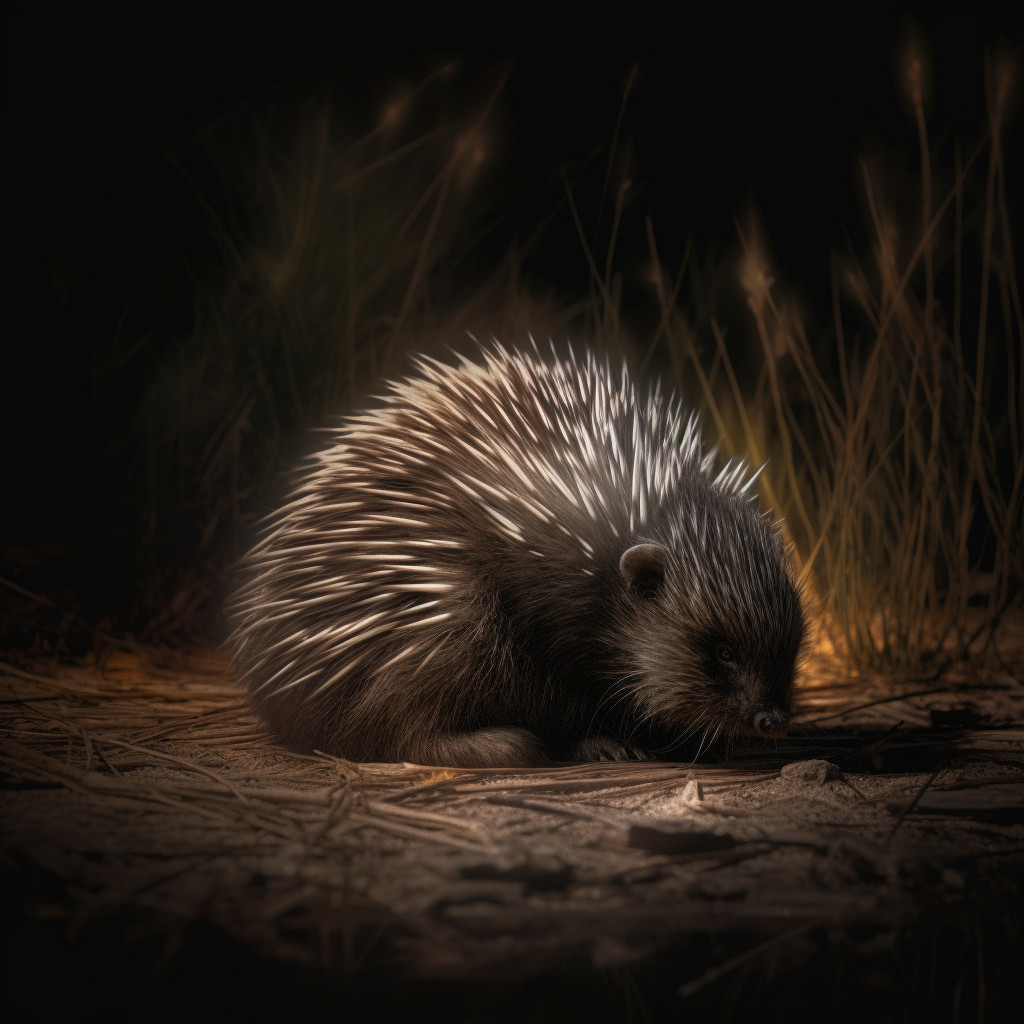
A. Do Porcupines Only Come Out at Night?
Porcupines are fascinating creatures known for their unique quills and nocturnal behavior. While it is true that porcupines are primarily nocturnal, meaning they are most active during the night, they are not exclusively active only at night. These solitary creatures can also be seen during the day, but they are more commonly spotted after the sun sets.
B. What Attracts Porcupines at Night?
Porcupines are attracted to various factors that make the night an ideal time for their activities. One of the main reasons porcupines prefer the cover of darkness is to avoid predators. By venturing out at night, they can take advantage of the reduced visibility and find safety in the shadows. Additionally, the cooler temperatures during the night make it more comfortable for these animals to forage for food and explore their surroundings.
C. The Nightly Activities of North American Porcupines
North American porcupines, also known as Erethizon dorsatum, are one of the most common species of porcupines found in the United States and Canada. These nocturnal rodents have a wide range of habitats, including forests, grasslands, and even deserts. During the night, they engage in various activities that help them survive and thrive in their environment.
-
Foraging for Food: Porcupines are herbivores, and their diet mainly consists of bark, twigs, leaves, and other plant materials. At night, they use their sharp incisors to gnaw on trees and shrubs, stripping away the outer layers to access the nutrient-rich inner bark. This behavior helps keep their teeth sharp and promotes healthy growth.
-
Exploring and Marking Territory: Porcupines are territorial animals and use scent marking to establish their boundaries. They have specialized scent glands located on their feet and tail, which they use to leave behind a distinctive odor on objects and surfaces. By exploring their surroundings at night, porcupines can mark their territory and communicate with other individuals in their vicinity.
-
Seeking Mates: Like many other nocturnal creatures, porcupines engage in mating activities during the night. They have a relatively long mating season, which typically occurs in late summer or early fall. Male porcupines will often engage in vocalizations and scent marking to attract females. Once a female is receptive, they will engage in a unique mating ritual that involves vocalizations, chasing, and physical contact.
-
Resting and Sleeping: While porcupines are primarily active at night, they still require rest and sleep. During the day, they retreat to their dens, which can be found in hollow trees, rock crevices, or underground burrows. These dens provide protection from predators and offer a safe and comfortable space for porcupines to rest and sleep.
In conclusion, porcupines are primarily nocturnal animals, but they can also be active during the day. The night offers them a favorable environment for foraging, exploring, and engaging in various activities. Understanding the nocturnal habits and behaviors of porcupines provides valuable insights into their biology and lifestyle.
Exploring Different Species of Porcupines

Porcupines are fascinating creatures that belong to the rodent family. While they share some common characteristics, there are different species of porcupines found across the world. In this section, we will explore the behavior and habits of different porcupine species and determine whether they are nocturnal or not.
A. Are All Porcupines Nocturnal?
When it comes to porcupine behavior, nocturnal activity is a common trait among many species. Nocturnal animals are those that are primarily active during the night and rest during the day. However, it is important to note that not all porcupines are strictly nocturnal.
Some porcupine species, such as the North American porcupine (Erethizon dorsatum), are indeed nocturnal. These porcupines are most active during the night, foraging for food and engaging in social interactions. They have adapted to the darkness by developing excellent night vision and a keen sense of smell.
On the other hand, there are porcupine species that exhibit more diurnal behavior, meaning they are active during the day. For example, the African crested porcupine (Hystrix cristata) is known to be more active during daylight hours. These porcupines have adapted to their habitat, which includes open grasslands and savannas, where they can easily find food and avoid predators.
B. Are Crested Porcupines Nocturnal?
The crested porcupine, as mentioned earlier, is a species that displays more diurnal behavior compared to other porcupines. They are native to Africa, Europe, and parts of Asia. These porcupines have a distinctive crest of long quills on their heads and backs, which they raise when threatened.
While crested porcupines are not strictly nocturnal, they are known to be most active during the late afternoon and early evening. This behavior allows them to take advantage of the remaining daylight to search for food, such as roots, bulbs, and bark. However, they may also be active during the night if necessary.
C. Are Porcupine Puffers Nocturnal?
Porcupine puffers, also known as porcupinefish, are a species of fish rather than mammals like the other porcupines mentioned. These unique-looking fish have a body covered in sharp spines, similar to the quills of porcupines.
Porcupine puffers are not nocturnal. They are typically active during the day and rest at night. These fish can often be found near coral reefs and rocky areas, where they feed on a variety of marine invertebrates and algae.
In conclusion, while many porcupine species exhibit nocturnal behavior, not all porcupines are strictly nocturnal. The North American porcupine is a prime example of a nocturnal porcupine, while the African crested porcupine displays more diurnal behavior. Porcupine puffers, on the other hand, are active during the day. Understanding the habits and behaviors of different porcupine species adds to our knowledge of these fascinating creatures and their adaptations to their respective habitats.
Porcupines Across North America
A. Where are Porcupines Found in North America?
Porcupines are fascinating creatures that can be found in various regions across North America. These unique animals are known for their sharp quills, which serve as a defense mechanism against predators. Let’s take a closer look at where porcupines can be found in North America.
| Region | Porcupine Species | |——–|——————| | Eastern United States | North American Porcupine | | Western United States | North American Porcupine | | Canada | North American Porcupine | | Alaska | North American Porcupine | | Mexico | Mexican Hairy Porcupine |
The North American Porcupine is the most common species found in North America. It can be found in the eastern and western parts of the United States, as well as in Canada and Alaska. These porcupines prefer forested areas with a mix of trees and open spaces, allowing them to forage for food and find suitable shelter.
In Mexico, the Mexican Hairy Porcupine is the species that can be found. These porcupines inhabit various habitats, including forests, grasslands, and even deserts. They are well-adapted to their environments and can thrive in different conditions.
B. The Nocturnal Lifestyle of North American Porcupines
One interesting aspect of porcupine behavior is their nocturnal lifestyle. Nocturnal animals are those that are primarily active during the night and rest during the day. North American porcupines are no exception to this rule.
Porcupines are well-suited for a nocturnal lifestyle due to their unique adaptations. Their quills, which are modified hairs, provide them with excellent protection against predators. These quills are sharp and barbed, making it difficult for predators to attack them. Additionally, porcupines have excellent night vision, allowing them to navigate their surroundings in low-light conditions.
During the night, porcupines engage in various activities such as foraging for food, socializing with other porcupines, and exploring their territory. They have a diverse diet that includes bark, leaves, twigs, and even fruits. Porcupines are excellent climbers and can use their strong claws and prehensile tail to maneuver through trees in search of food.
When it comes to sleeping habits, porcupines are known to build nests called “dreys” in trees. These nests provide them with a safe and comfortable place to rest during the day. Porcupines are solitary animals, and each individual typically has its own drey.
In conclusion, porcupines are fascinating creatures that can be found across North America. They have adapted to a nocturnal lifestyle, allowing them to thrive in their environments. Whether it’s the North American Porcupine in the United States and Canada or the Mexican Hairy Porcupine in Mexico, these animals play an important role in the ecosystem. Their unique characteristics and behaviors make them a truly remarkable species.
The Birth and Life Cycle of Porcupines
A. How are Porcupines Born?
Porcupines are fascinating creatures with unique reproductive habits. The birth of a porcupine is an intriguing process that showcases the remarkable adaptations of these animals. Let’s delve into the details of how porcupines are born.
-
Gestation Period: Female porcupines have a relatively long gestation period, lasting around 112 days. During this time, the mother porcupine carries her young ones in her womb, ensuring their proper development.
-
Litter Size: Porcupines typically give birth to one or two offspring at a time. However, there have been instances where litters of up to four young porcupines have been observed.
-
Birth: When it’s time for the porcupine to give birth, she retreats to a secluded den or burrow to ensure the safety of her newborns. These dens are usually located in rocky crevices, hollow trees, or underground tunnels.
-
Quills at Birth: One of the most fascinating aspects of porcupine birth is that the newborns already possess soft and flexible quills. These quills harden within a few hours after birth, providing the young porcupines with their first line of defense.
-
Maternal Care: After birth, the mother porcupine takes great care of her offspring. She nurses them, keeping them close and protecting them from potential predators. The young porcupines rely on their mother’s milk for sustenance during their early stages of life.
B. The Development of Nocturnal Habits in Young Porcupines
As young porcupines grow, they gradually develop nocturnal habits. This adaptation plays a crucial role in their survival and lifestyle. Let’s explore how young porcupines transition into nocturnal creatures.
-
Early Life: During the first few weeks of their lives, young porcupines are relatively immobile and rely heavily on their mother for protection and nourishment. They spend most of their time in the safety of their den, venturing out only when their mother accompanies them.
-
Exploration: As the young porcupines grow older, they start to explore their surroundings under the watchful eye of their mother. These exploratory outings help them become familiar with their environment and develop their senses.
-
Nocturnal Behavior: Around the age of three months, young porcupines begin to exhibit nocturnal behavior. This shift in activity patterns is believed to be an adaptation that helps them avoid predators and find food more efficiently.
-
Feeding Habits: Nocturnal behavior in porcupines is closely tied to their feeding habits. These creatures are herbivores, primarily feeding on bark, twigs, leaves, and other plant materials. By becoming nocturnal, they can take advantage of the cover of darkness to forage for food without attracting unwanted attention.
-
Adult Nocturnal Lifestyle: As young porcupines mature into adults, their nocturnal habits become more pronounced. Adult porcupines are primarily active during the night, spending their days resting in trees or hidden in dense vegetation.
The birth and life cycle of porcupines offer a fascinating glimpse into the world of these unique creatures. From the remarkable birth process to the development of nocturnal habits, porcupines showcase a range of adaptations that contribute to their survival in the wild. Understanding these aspects of porcupine biology helps us appreciate the intricacies of nature and the diversity of life on our planet. Conclusion
In conclusion, porcupines are primarily nocturnal animals, meaning they are most active during the night. This behavior allows them to avoid predators and forage for food in relative safety. However, it is important to note that not all porcupine species are strictly nocturnal, as some may also be active during the day to varying degrees. The nocturnal nature of porcupines is attributed to their evolutionary adaptations and natural instincts. By being active at night, porcupines have developed a survival strategy that has helped them thrive in various habitats around the world. Whether they are climbing trees or foraging on the forest floor, these fascinating creatures have adapted to their nocturnal lifestyle in remarkable ways. So, the next time you come across a porcupine, keep in mind that it is most likely to be out and about during the cover of darkness.
Frequently Asked Questions
Do porcupines only come out at night?
Yes, porcupines are primarily nocturnal animals. They tend to be most active during the night and sleep during the day, which is a common behavior among nocturnal animals.
When are porcupines most active?
Porcupines are most active during the night. They are nocturnal creatures, meaning they sleep during the day and become active after dusk.
Are porcupines nocturnal or diurnal?
Porcupines are nocturnal animals. This means they are active during the night and rest during the day. This is a common characteristic among many rodent species.
What time of day are porcupines active?
Porcupines are typically active during the night. As nocturnal animals, they sleep during the day and start their activities after sunset.
Are porcupine puffers nocturnal?
Yes, like many other species of porcupines, porcupine puffers are also nocturnal. They are most active during the night.
Where are porcupines native?
Porcupines are native to various regions across the world. They are found in North and South America, Africa, Europe, and Asia. Their habitat varies from forests and deserts to grasslands depending on the species.
Why are porcupines nocturnal?
Porcupines are nocturnal primarily as a survival strategy. Being active at night helps them avoid many predators that are active during the day. It also allows them to take advantage of food resources that may not be available during daylight hours.
How are porcupines born?
Porcupines give birth to live young, known as porcupettes. The porcupettes are born with soft quills, which harden within a few hours after birth.
What attracts porcupines?
Porcupines are attracted to anything salty. They have been known to chew on wooden structures or objects that have human sweat on them. They are also attracted to certain types of vegetation that make up their diet.
Are all porcupines nocturnal?
Yes, all species of porcupines are nocturnal. They sleep during the day and are active at night. This nocturnal behavior is a common characteristic among porcupines worldwide.

